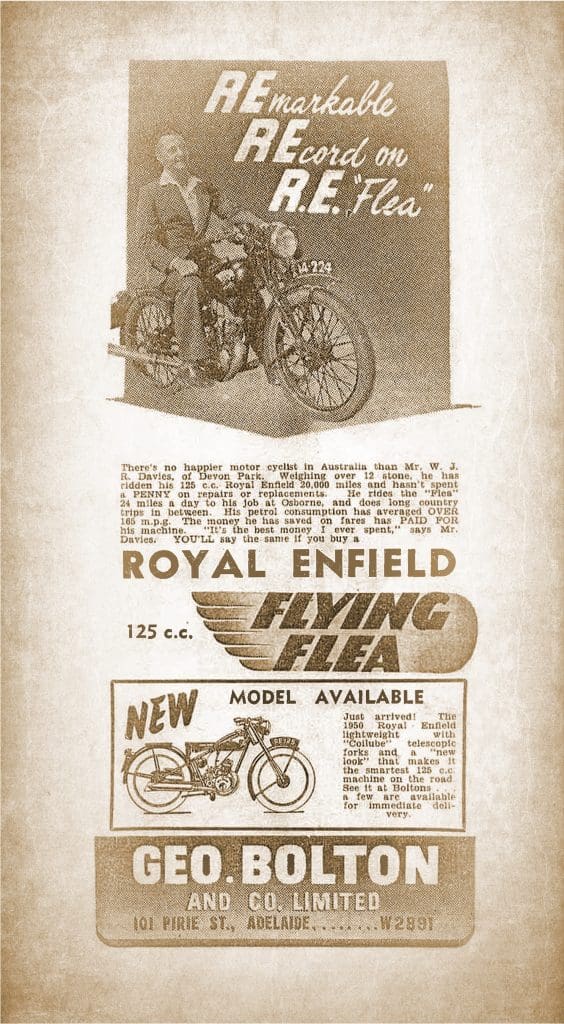Royal Enfield’s 125cc baby proved ideal for post-WWII petrol rationing
With the outbreak of the Second World War the new Ted Pardoe-designed 125cc two-stroke ‘baby Royal Enfield’ became the WD/RE; the ‘War Department Royal Enfield’. These bikes could run on any fuel and their light weight meant soldiers could carry them over otherwise impassable terrain. When the war ceased, the huge demand for cheap and reliable transport meant any surviving models were repainted for civilian use. But the cost and availability of petrol remained prohibitive; five cents a litre seems a pittance now, however, the average wage of $12 a week puts that into perspective.
Little wonder then that the ‘Flying Flea’ became an instant sales success. With its unique selling proposition, the Flea was an advertising copywriter’s wet dream. “There’s a Power of STING in these FLYING FLEAS” stated the headline, followed by this remarkable hyperbole: “It’s mighty small… it’s mighty light… just a flea bite of a motor cycle! But don’t be deceived, dear sire, this mite is MIGHTY TOUGH and packs a sting that’ll surprise you. British paratroopers PROVED the qualities of the Royal Enfield Flying Flea in the Normandy campaign. The Flea, in fact was a veritable two-banger bulldozer so far as obstacles were concerned. Now, of course, the Flea has been nicely dressed, but make no mistake, it’s STILL the paratrooper’s machine at heart … same engine … same everything except the smart black and silver suit. A penny buys a 3 mile ride. For riding to and from work there’s no proposition to compare with a 125cc Royal Enfield Flying Flea. A Flea does over 130mpg. Taking oil and running costs into account, if you live 1½ miles from your job you can travel back and forth five days a week for five pence.”
Flea owners were quick to embellish their exploits. Mr D Haig wrote to say: “four months ago I purchased a Royal Enfield Flying Flea and during my holidays I made a trip to Broken Hill. The whole distance I covered was 695 miles using only five gallons of petrol [less than 23 litres for over 1100km!]. I was really very astounded at the performance of this truly remarkable machine. I never had cause to use a spanner or put any air in my tyres. My cruising speed was 40 mph without any effort. Not to be outdone, two women, a West Australian, Miss Elsie Joss, and her Victorian companion ‘Tony’ Aldridge rode from Melbourne to Port Pirie, caught the train to Kalgoorlie then rode on to Perth. Then the Reverend Donald Campbell (no we’re not making this up) claimed to have ridden 1726 miles on 12 gallons of petrol [2778km on 54.5 litres] while traversing some of Victoria’s steepest mountain country. On the run from Warrnambool to Millicent he achieved 178mpg [1.59L/100km] and claimed: “My Flying Flea didn’t falter once. I was really delighted with its performance and rugged reliability”. And, in terms of rugged reliability, the Flea was the adventure tourer of its day according to theological student KD Johns, whose Flea ploughed through creeks without protest on an 1125km jaunt over the stony tracks of the rugged Flinders Ranges.
But not as rugged as Mr AJ Hawkins of Forest Gardens. ‘AJ’ tipped the scales at 17 stone 2lb and his pillion weighed 12 stone 4lb – that’s a combined weight of 187kg – yet his Flea never failed to achieve 140mpg (2L/100km) on shooting excursions through the Adelaide Hills.
Of the thousands of Fleas that made it to Australian shores post WWII, most died with their boots on – victims of minimal maintenance and wonky electrics. Many more were dismantled as the robust Villiers two-stroke found its way into home-built go-karts during the 1960s.
Today, with fuel prices over a dollar, we could all use a two-wheeled commuter that would get 60 kilometres to the litre.

By Peter Whitaker